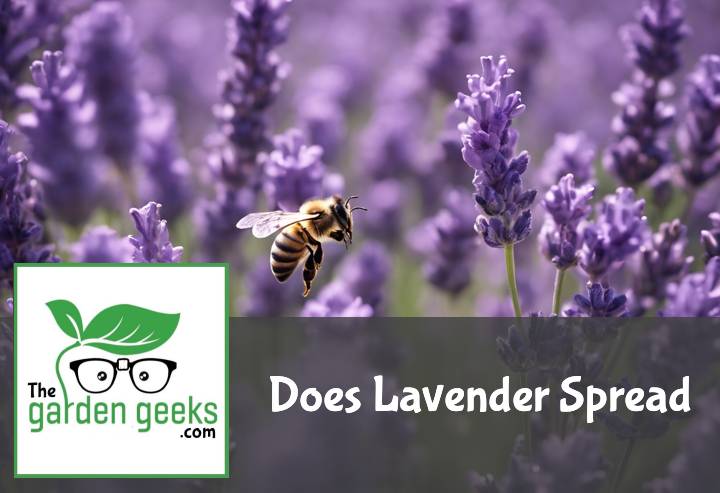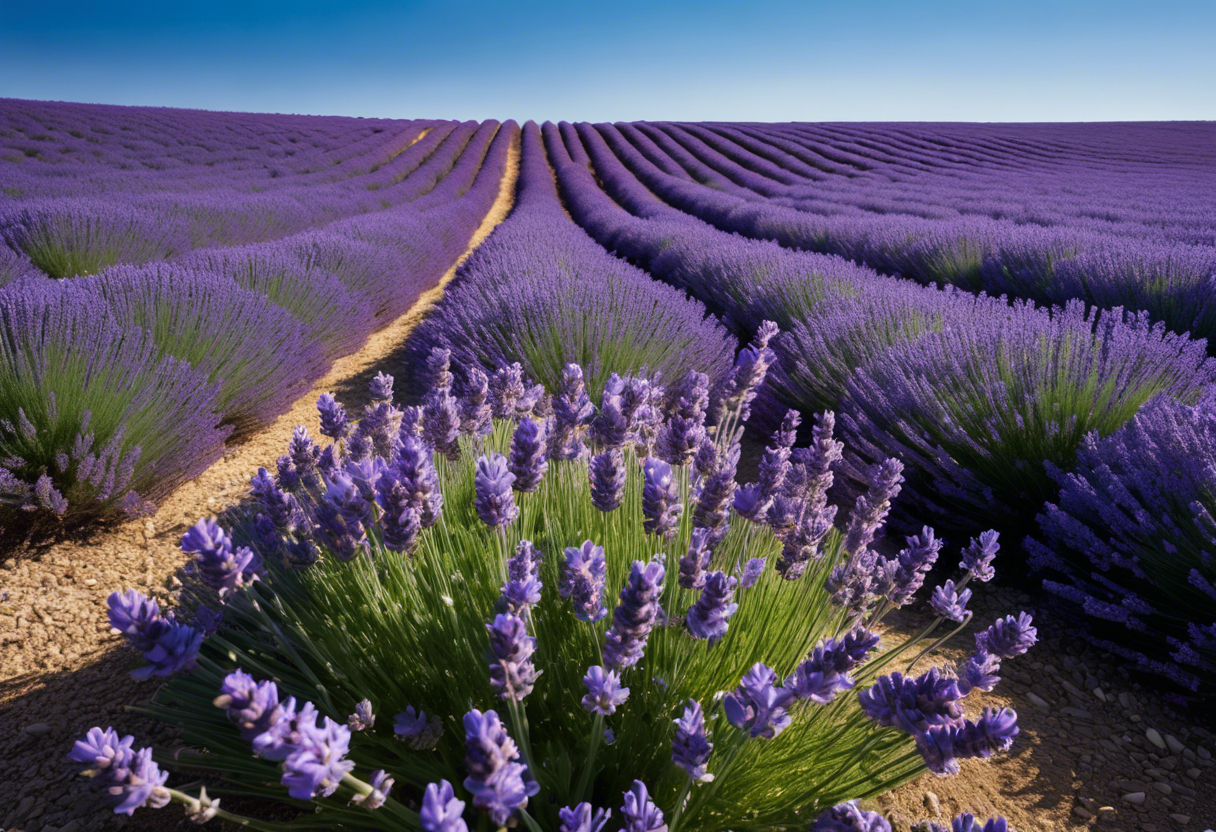Ever found yourself wondering, Does Lavender Spread? Well, you’re not alone. As a self-proclaimed lavender enthusiast (or ‘lavendophile’, if you will), I’ve spent countless hours pondering this very question.
So, does it spread like wildfire or stand its ground like a solitary soldier? Keep reading to find out more about this aromatic enigma!
Key Takeaways
- Lavender does spread but at a slow pace, typically taking several years to expand significantly.
- It spreads through a process called layering where lower branches touch the ground and develop roots, forming new plants.
- The rate of spreading can be influenced by factors such as soil quality, sunlight exposure, and proper pruning.
- Despite its ability to spread, lavender is not considered invasive due to its slow growth rate.
Understanding Lavender Growth
Lavender, a plant known for its beautiful purple flowers and soothing scent, has some unique growth characteristics. It’s not just about planting it and waiting for the magic to happen. There are certain lavender growing conditions that need to be met.
What is Lavender?
Lavender is a member of the mint family, believe it or not! Botanically speaking, it’s known as Lavandula. This genus includes 47 known species of flowering plants. The most common type you’ll probably encounter in your local garden center is Lavandula angustifolia, also known as English lavender.
These plants are characterized by their lovely purple flowers and silvery-green foliage. They’re native to the Mediterranean region but have been cultivated worldwide due to their beauty and versatility. The lavender plant features include long-lasting blooms and a heavenly scent that’s used in everything from perfumes to culinary dishes.
How Does Lavender Grow?
Now let’s get down to the nitty-gritty: how does lavender grow? Well, it all starts with lavender seed germination. This process can be a bit tricky since lavender seeds require light for germination and can take anywhere from two weeks to a month to sprout.
Once they’ve sprouted, the little seedlings will slowly start to develop into mature plants over several months. During this time, they’ll go through various stages of lavender growth, including vegetative growth (where they produce leaves) and reproductive growth (where they produce those iconic purple flowers).
But here’s the kicker: lavender isn’t just picky about where it grows—it also needs specific conditions to thrive. Factors such as soil type, sunlight exposure, and water availability can significantly affect how well your lavender plant grows. So if you’re thinking about adding some of these beauties to your garden, make sure you’ve got the right factors affecting lavender growth in place!
Does Lavender Spread?
Well, to answer the question, Does Lavender Spread? Yes, it does! But hold your horses, it’s not as simple as that. The spread of lavender depends on a variety of factors. It’s not just about planting and hoping for the best. No siree! You’ve got to consider things like lavender growth, lavender propagation, and how you’re caring for your lavender plant.
Factors Influencing Lavender Spread
Now let’s talk about what influences the spread of lavender. First off, there are the environmental conditions. Just like us humans, plants have their preferences too! Lavender soil conditions play a big role in how well your lavender will spread. They love well-drained soil and plenty of sunlight. So if you’re trying to grow lavender in a dark corner with soggy soil, you might be outta luck!
Next up is plant health. A healthy plant is a spreading plant! Proper watering and pruning practices can make all the difference when it comes to healthy lavender growth. Too much water can lead to root rot while inadequate pruning can hinder growth.
Finally, cultivation practices come into play. How you care for your lavender will affect its ability to spread. Regular feeding with appropriate fertilizers and pest control measures are crucial for promoting spreading lavender plants.
Rate of Lavender Spread
Alrighty then! Now that we know what affects lavender spread let’s look at how quickly this happens under optimal conditions. Generally speaking, lavenders aren’t exactly Usain Bolt when it comes to spreading speed but they do make steady progress.
There are variations between different types of lavenders though – some are sprinters while others are more marathon runners! For instance, English lavenders tend to be slower growers compared to their French counterparts (English lavender spread rate vs French lavender spread rate).
But remember, even the fastest-growing lavender won’t spread if it’s not given the right conditions. So make sure you’re providing your lavender with all it needs to thrive and spread!
How to Manage Lavender Spread
Managing the spread of your lavender plants is crucial for maintaining a well-kept garden. It’s all about balance, folks! You want your lavender to flourish, but not overrun your other plants. There are two main methods for controlling the growth: pruning techniques and appropriate spacing for planting.
Pruning Techniques for Controlling Spread
Now, let’s talk about pruning. Pruning your lavender plants can be an effective way to control their spread. It’s like giving your plant a haircut! Regular trims keep it looking neat and prevent it from growing too wild.
But how do you prune a lavender plant? Well, it’s pretty simple. Just grab some sharp shears and trim back the stems after they’ve flowered. This helps control the size of the plant and encourages more blooms next season.
Remember, though, don’t go too crazy with the shears! Over-pruning can stress out your plant and stunt its growth. So keep it moderate, folks!
Appropriate Spacing for Planting
The second method we’re discussing today is appropriate spacing during planting. Think of it as social distancing for your lavenders! Giving each plant enough room to grow prevents overcrowding and controls spread.
When planting lavenders, make sure there’s enough distance between each one. This allows them to grow freely without competing for resources or space.
So what’s the ideal space for planting lavenders? Generally speaking, most gardeners recommend leaving about 2-3 feet between each plant. But remember, every garden is unique so adjust as needed!
In conclusion, managing lavender in your garden doesn’t have to be a chore. With proper pruning techniques and appropriate spacing during planting, you’ll have a beautifully controlled lavender display in no time!
Benefits and Drawbacks of Lavender Spreading
When it comes to the question, Does Lavender Spread? Well, yes, it does. And like most things in life, this comes with its own set of pros and cons. Let’s delve into the benefits and potential issues that come with lavender spreading.
Advantages of Lavender Spreading
There’s a lot to love about lavender spreading across your garden. For starters, the aesthetic benefits of lavender spread are undeniable. A sea of purple blooms can transform any space into a picturesque haven.
Then there’s the fragrance. Oh boy! The fragrance from spreading lavender is simply divine! It fills the air with a soothing scent that can calm even the most frazzled nerves.
And let’s not forget about our little buzzing friends – bees! They absolutely adore lavender. So, by allowing your lavender to spread, you’re also contributing to local ecology. Yes indeed, there are some pretty cool ecological advantages of lavender proliferation.
Potential Problems with Uncontrolled Spread
However, it’s not all sunshine and rainbows when it comes to lavender spreading willy-nilly. One issue that can crop up is garden domination by lavender. This plant isn’t shy about taking over space if left unchecked.
Another potential problem could be allergies. Some folks might have allergic reactions to lavender, and an overgrowth could exacerbate these symptoms.
Lastly, there might be some unforeseen issues with uncontrolled lavender spread, like affecting other plants’ growth or becoming difficult to manage over time.
So while spreading lavender has its perks, it’s important to keep an eye on things so they don’t get outta hand!
To Wrap Up
So, we’ve been on a journey together, like bees buzzing around a lavender field. We’ve answered the question, ‘Does Lavender Spread‘, and learned that it can indeed spread, but at a pace slower than a snail sipping iced tea in the sun.
Our final thought? Lavender is not only pretty and fragrant but also low maintenance. So why not give growing some a whirl? You’ll be reaping the benefits before you know it!





